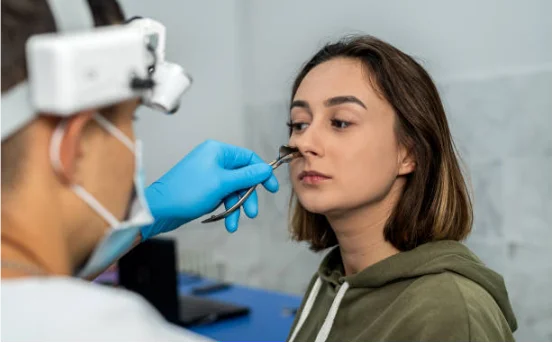Endoscopic Endonasal Surgery (EES) is a revolutionary minimally invasive surgical procedure utilized to remove lesions or tumors that are that are located in the apex of the brain, skull or in the upper part of the spine. Instead of the traditional open-brain surgery that requires huge incisions EES permits neurosurgeons perform surgery via the natural passageways of the nasal cavity by using a tiny endoscope, a high-definition camera inserted into an extremely thin tube.
This method has numerous advantages including less scarring, faster recovery and less hassle. It has changed the way neurosurgeons deal with complex issues and offers patients more secure options that provide comparable or better results.
As demand increases for brain surgeries that are minimally invasive, EES stands out as an effective tool for the treatment of diseases like pituitary tumors and meningiomas, craniopharyngiomas, as well as brain base cysts.
Why Endoscopic Endonasal Surgery is Preferred
- Minimally Invasive Access :- The most attractive characteristics of EES is the fact that it doesn’t need cutting into the skull. Instead, it makes use of the nostrils as a route to reach the brain’s internal structures. This drastically reduces injuries, scarring, as well as hospitalization.
- Faster Recovery Time :- As the tissue is not damaged and there are no surgical incisions made to the skin, patients generally have a quicker recovery and less postoperative pain and faster return to everyday activities than conventional craniotomies.
- Improved Visualization :- The high-resolution camera in the endoscope gives clear and magnified views of the site of surgery which allows for the precise removal of tumors and protecting the surrounding structures that are vital to the process, such as nerves and blood vessels.
- Lower Risk of Infection :- In avoiding the need for large incisions on the outside, EES significantly reduces the chance of getting infections, making it a more secure option especially for older patients or those who have weak immune systems.
Symptoms Indicating the Need for Endoscopic Endonasal Surgery
Although EES involves a surgical procedure not a condition that is a condition, it is usually used in patients with symptoms caused by cysts or tumors that are located near the pituitary or skull base gland. The most common symptoms are:
- Headaches that persist
- Vision issues (e.g. blurry, double vision)
- Insufficiencies in hormones (due in pituitary tumors)
- Tingling or facial numbness
- The nose may be swollen or nasal constrictions (in the cases of sinus or nasal tumors)
- The loss of smell
- Cognitive changes or seizures (in advanced cases)
If you or someone close to you has a mix with these signs, an ENT or neurologist ENT specialist might recommend imaging studies and look into EES as a possible treatment alternative.
Causes Leading to the Need for Endoscopic Endonasal Surgery
Endoscopic Endonasal Surgery is commonly utilized to treat:
- Pituitary Adenomas :- Pituitary gland can impact the production of hormones and vision.
- Craniopharyngiomas :- The non-cancerous growths that surround the pituitary gland could alter the hormones that are responsible for vision and affect hormone function.
- Skull Base Tumors :- Tumors that grow around the brain’s base, which includes meningiomas as well as chordomas, may cause brain structures to be compressed and need removal.
- Cerebrospinal Fluid (CSF) Leak :-Sometimes, they are caused by surgery, trauma, or tumours CSF leaks may be treated with EES techniques.
- Sinonasal Malignancies :- Cancers that originate in the sinuses or nasal cavities can be eliminated using endoscopic procedures.
The causes of these issues often cause symptoms that interfere with daily living and can pose serious health risks if not treated.
Diagnosis Before Endoscopic Endonasal Surgery
The correct diagnosis is essential in determining if the patient is a candidate for EES. The procedure of diagnosing typically comprises:
- Neurological and Physical Examination :- Doctors evaluate the patient’s neurologic health and vision, as well as the levels of hormones, and reflexes.
- MRI or CT Scan :- These imaging tests provide precise information about the location, size and shape of the lesion or tumor.
- Endoscopy :- A nasal endoscopy can be done to examine the nasal passages as well as sinus regions.
- Hormonal Testing :- If pituitary tumors are suspected hormone levels are assessed to determine gland function.
- Biopsy (if necessary) :- In some instances the need for a biopsy may be necessary to determine the malignant or benign.
An multidisciplinary group, typically comprised of a neurosurgeon ENT specialist and an endocrinologist is collaborating to design the procedure.
Treatment: How Endoscopic Endonasal Surgery Works
Surgical Process
The procedure is generally done with general anesthesia. Neurosurgeons and ENT surgeon place an endoscope into the nostrils of one or both in order to access the surgical area. Instruments that are specially designed are used along with an endoscope in order to remove the tumor or fix damage.
Neuronavigation and real-time imaging systems aid in determining the safest and most efficient route. After the lesion or tumor is gone, the site is sealed and no stitches externally are needed.
Post-Surgery Recovery
- Most patients stay within the hospitals for between 2 and 5 days.
- A mild nasal congestion headaches, fatigue and nasal congestion are not uncommon at first.
- Nasal care and follow-up imaging can help to ensure the healing process.
- Hormonal replacement therapy could be necessary if the pituitary’s function is impaired.
Rehabilitation and Monitoring
Patients might require:
- Hormonal therapy
- Vision therapy
- Therapy in the form of occupational therapy or physical therapy (if there were neurological problems)
Regular follow-ups as well as MRI scans are necessary to determine if there is a recurrence or remaining tumor.
Conclusion
Endoscopic Endonasal Surgery represents a significant improvement in neurosurgical procedures, providing an easier, safer and more efficient alternatives to the traditional surgery for brain. From speedier recovery to fewer complications, this revolutionary procedure is changing the treatment of pituitary and skull base tumors.
For patients who have tumors close to the skull’s base or nasal area, EES can provide new prospects and improve the standard of living. If you’re suffering from constant symptoms or diagnosed with a related condition you should consult a specialist neurosurgeon to determine if Endoscopic Endonasal Surgery is right for you.























